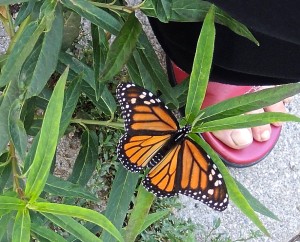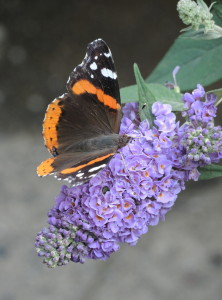 At the entrance to Hoboken, my hometown, are several signs: “Bike-friendly community,” “Nuclear-free zone,” and even “Mental condition stigma-free zone.” I’d like to add my own sign to the group—one that is at least as accurate as those: “Butterfly-friendly zone.” At the start of the season, I planted lots of butterfly-friendly plants—lantanas, butterfly bushes, zinnias, along with dill and parsley for the black swallowtail butterflies. I’ve been rewarded with numerous sightings of black swallowtails, red admirals (photo, left), and cabbage white butterflies. But one customary visitor has been in short supply—monarchs.
At the entrance to Hoboken, my hometown, are several signs: “Bike-friendly community,” “Nuclear-free zone,” and even “Mental condition stigma-free zone.” I’d like to add my own sign to the group—one that is at least as accurate as those: “Butterfly-friendly zone.” At the start of the season, I planted lots of butterfly-friendly plants—lantanas, butterfly bushes, zinnias, along with dill and parsley for the black swallowtail butterflies. I’ve been rewarded with numerous sightings of black swallowtails, red admirals (photo, left), and cabbage white butterflies. But one customary visitor has been in short supply—monarchs.
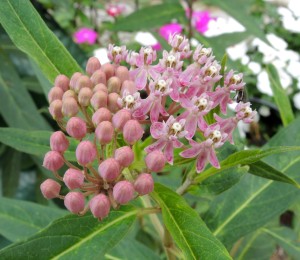 The past few years have been tough ones for monarch butterflies, as their population has plummeted—falling victim to habitat loss and yards doused with toxic pesticides and herbicides. Milkweed is the only plant that monarchs lay their eggs on. The leaves and milky sap feed the caterpillars, while the flowers (right) provide nectar for the adult butterflies. Yet the weeds are unwelcome in tidy yards and have largely been eradicated by homeowners.
The past few years have been tough ones for monarch butterflies, as their population has plummeted—falling victim to habitat loss and yards doused with toxic pesticides and herbicides. Milkweed is the only plant that monarchs lay their eggs on. The leaves and milky sap feed the caterpillars, while the flowers (right) provide nectar for the adult butterflies. Yet the weeds are unwelcome in tidy yards and have largely been eradicated by homeowners.
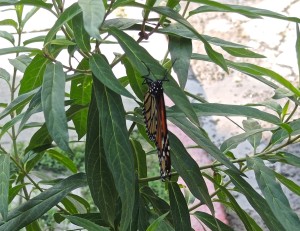 Last spring, I decided to help by ordering milkweed from Monarch Watch. My husband objected, of course. He pointed out that the stuff grows wild in the Great Swamp (which is a real place, this being New Jersey). “We could just go and collect some,” he said. But when would we really take the time to do it? I placed an order for an entire flat—32 plugs—which is a lot of milkweed for a container garden. Still, when my weeds arrived, I let out a small yelp of delight. I immediately opened the box and breathed in the deep, rich scent of the earth. Then I ran outside to plant them in nice organic soil. I even gave them mulch. (Am I crazy, or what, pampering my weeds? Good thing Hoboken is a “mental condition stigma-free zone”!)
Last spring, I decided to help by ordering milkweed from Monarch Watch. My husband objected, of course. He pointed out that the stuff grows wild in the Great Swamp (which is a real place, this being New Jersey). “We could just go and collect some,” he said. But when would we really take the time to do it? I placed an order for an entire flat—32 plugs—which is a lot of milkweed for a container garden. Still, when my weeds arrived, I let out a small yelp of delight. I immediately opened the box and breathed in the deep, rich scent of the earth. Then I ran outside to plant them in nice organic soil. I even gave them mulch. (Am I crazy, or what, pampering my weeds? Good thing Hoboken is a “mental condition stigma-free zone”!)
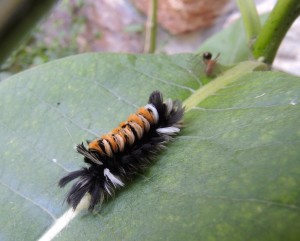 I’ve seen a number of monarchs in my garden this summer, mainly on the other nectar flowers. But I’ve only spotted one monarch on the milkweed (photos, directly above and at the bottom)—and I haven’t seen a single monarch caterpillar, though I’ve regularly checked the undersides of leaves for eggs and larvae. (The curious little guy on the left—the caterpillar of a milkweed tussock moth—was on someone else’s milkweed.)
I’ve seen a number of monarchs in my garden this summer, mainly on the other nectar flowers. But I’ve only spotted one monarch on the milkweed (photos, directly above and at the bottom)—and I haven’t seen a single monarch caterpillar, though I’ve regularly checked the undersides of leaves for eggs and larvae. (The curious little guy on the left—the caterpillar of a milkweed tussock moth—was on someone else’s milkweed.)
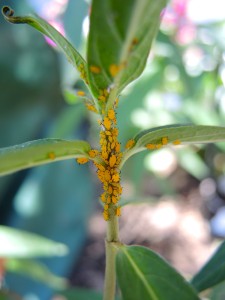
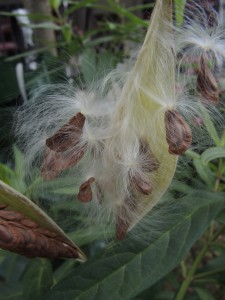 Mainly what I’ve attracted this year, in frightening abundance, are these bright yellow aphids (left). But next year is another season, and I’m sure I’ll have more milkweed. At the end of the summer, the plant forms these seed pods (right). Mine produced a bumper crop. Carried on the wind, they’ve now dispersed throughout the neighborhood–whether the neighbors want them or not.
Mainly what I’ve attracted this year, in frightening abundance, are these bright yellow aphids (left). But next year is another season, and I’m sure I’ll have more milkweed. At the end of the summer, the plant forms these seed pods (right). Mine produced a bumper crop. Carried on the wind, they’ve now dispersed throughout the neighborhood–whether the neighbors want them or not. 